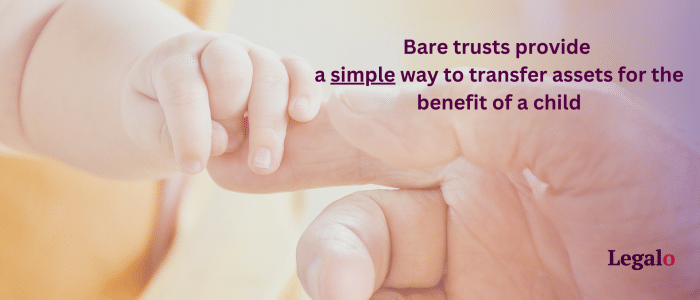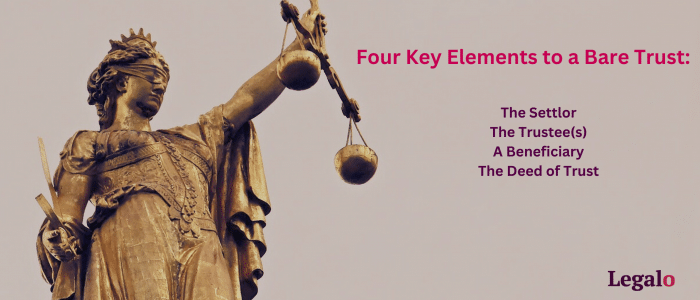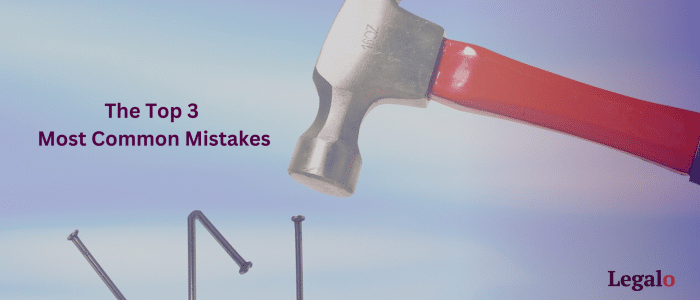How to Set Up a Bare Trust
Stephen Avila
Here in the UK it is simple to set up a bare trust. It is something that you can do yourself without needing to hire a solicitor.
In this guide we take you through the steps to follow if you want to set up your own bare trust.
Overview of a Bare Trust
A bare trust (which is also commonly known as a simple trust) is a simple legal arrangement where assets are put into trust for the benefit of another person (called the ‘beneficiary’).
Under the trust a person(called the trustee) holds assets for the benefit of the beneficiary.
Unlike other types of trusts, for example a discretionary trust, a bare trust gives the beneficiary an absolute right to both the capital and the income from the trust.
The role of the trustee is therefore purely administrative as they manage the asset(s) in the trust for the benefit of the beneficiary.
The trustee must at all times manage the trust asst in the best interests of the beneficiary.
Once the beneficiary reaches 18 years of age the trustee must act in accordance with any instruction that the beneficiary gives them.
The Importance of Setting Up a Bare Trust

Bare trusts are most commonly used as a way to hold an asset on behalf of a child. The trust normally holds the asset until the child reaches 18 years of age.
This can provide for a very effective and simple way for transfer of the asset to the child, but with an adult managing the asset until the child reaches adulthood.
It may not be attractive to a parent or grandparent to transfer cash to the child directly whilst they remain a minor.
For property, it is not legally possible to transfer UK property to a child, so you must use a trust to hold the property on their behalf until they turn 18.
There can be tax benefits of transferring an asset to a child early as the transfer will be a Potentially Exempt Transfer for inheritance tax purposes. It will be subject to the 7 year rule on IHT tax.
Leaving the transfer until a later date increases the chance of tax becoming payable if the person transferring the asset dies.
Key Considerations for Setting Up a Trust
Before setting up a bare trust take some time out to understand how this type of trust works, as well as how to set up the trust.
What are your own needs?
Before setting up a bare trust, think about your own specific needs and the circumstances that apply to you personally. You should ask yourself:
- Is a bare trust suitable for my situation? Yes, a bare trust is very simple to set up but it is also inflexible. You cannot cancel it once set up and you cannot change the beneficiary.
- Who do you intend to be the beneficiary? Keep in mind that because it is not possible to change the beneficiary after you have set up the trust, you must be sure that you will not want to change your mind later.
- What about tax implications? There is generally no tax to pay when transferring an asset into a bare trust. Any income the trust receives from the asset will be taxed as income of the beneficiary. However, the transfer may become subject to inheritance tax. The Government website covers this in detail.
- Who will be the Trustees? The trustee will be responsible for managing the asset in the trust so you must give careful consideration to who that is. You can appoint yourself as a trustee if you wish. The minimum number of trustees is one but two is preferable
Legal Documents
A legally valid bare trust deed must be put in place. You can either engage a solicitor to prepare the trust deed for you, or create one yourself.
Given the simplicity of the bare trust deed it is common for people setting up a trust to produce it themselves.
If you decide to set the bare trust up yourself make sure you use a suitable bare trust deed template.
We recommend our own template which has been drafted by David, a co founder of Legal and a practising solicitor in England.
Choosing Beneficiaries
Anyone can be named as the beneficiary of the trust that you set up. It is common for the beneficiary to be a child.
Keep in mind that once set up the beneficiary can’t be changed. You have effectively gifted the trust asset to the beneficiary and can’t take it back.
It is therefore critical that you carefully consider your beneficiary and your desire to transfer the asset to them before you set up your bare trust.
Key Components of a Bare Trust

There are 4 key components to a bare trust which we cover below
Settlor
The settlor is you – i.e. the person that creates the trust by transferring the asset(s) into the trust. As the settlor you decode on the terms of the trust.
This will include the asset covered by the trust and the individuals who will be appointed as the trustees to manage the asset.
As we have said above you, as the settlor, can also be the trustee which is common with family trusts. It is advisable to have two trustees in case something happens to you.
Trustee
The trustee is the person that is responsible for managing the trust that you will set up. That person must manage the trust for the best interests of the beneficiary.
Once the beneficiary turns 18 the trustee must act in accordance with any instruction given to them by the beneficiary.
With bare trusts it is common to set them up so that the asset transfers completely to the beneficiary when the beneficiary reaches 18 years of age.
You can set up the trust so that the asset can be held in the trust until a date after the beneficiary turns 18. However, please note that the beneficiary can, if they choose to do so, override this once they turn 18.
Beneficiary
The beneficiary of a bare trust is the person that will receive the asset that is in the trust. As we have said the beneficiary has an absolute right to the asset once they become an adult. In the UK this is 18 years of age.
Once the person turns 18 they have an absolute right to the trust’s assets and income. This means that once they reach the age of 18, they can demand the transfer of all assets held in the trust. For this reason you should consider the beneficiary’s ability to actually manage these assets responsibly once they receive them.
Trust Deed
The trust deed is the legal document that establishes the trust. The document will set out the terms of the trust. This will include the identity of the settlor, the trustee, and the beneficiary.
It will also set out the assets you placed into the trust. You usually list the assets in the schedule to the trust deed.
The trust deed will specify the instructions to the trustee for managing the asset and their responsibilities. Any conditions under which the assets can be transferred to the beneficiary will also be set out.
Although, as noted above once the beneficiary turns 18 then they have an absolute right to receive the asset.
If you decide to set up the trust yourself then we recommend using our template bare trust deed to do this.
Our Step-by-Step Guide to Setting Up a Bare Trust

Step 1: Identify the Assets to Be Held in Trust
The first step in setting up a bare trust is deciding which assets will be placed into the trust. Common assets include:
- Cash: It is common that a person setting up a bare trust does so because they don’t want the beneficiary to receive the cash until they are 18.
- Property: As a result of it not being legally possible to transfer property to a person under 18 it is common for it to be put into a trust.
- Investments: Shares, bonds, or other investments are also common assets that are put into a trust for the benefit of a minor.
Step 2: Decide on the Beneficiary of the Trust
You can select any person to be the beneficiary of the trust. Most commonly they will be either a:
- Child; or
- Grandchild
Step 3: Draft the Trust Deed
The trust deed is the most important document in the trust arrangement. It should clearly outline:
- The settlor: This is the person creating the trust.
- The trustee: This is the person (it can also be a company) that is responsible for managing the trust.
- Trustee powers: The trust deed will need to set out the powers that are granted to the trustee to manage the asset being put into trust. For example, the ability to manage or invest the asset(s) until the beneficiary turns 18.
- The beneficiary: This is the person who will ultimately receive the asset being put into trust.
- The assets: Assets should be very clearly defined in the Schedule of the trust deed. For example, you should identify cash in a bank by the account details. You should identify property by its title number.
Step 4: Choose a Trustee
Keep in mind that depending on the age of the beneficiary the trustee may manage the trust for many years after you have set it up.
Choosing the right trustee is therefore crucial. With family related trusts it is common for the person setting up the trust (the ‘Settlor’) to appoint themselves as a trustee.
Where this is a grandparent it is common to also appoint a parent as a second trustee. You can set up a simple bare trust with just one trustee but two is preferable.
A company can be a trustee and sometimes people will choose a professional trustee company to appoint.
This ensures that the trust continues if something happens to one of the trustees.
The characteristics below are things that you should consider when deciding who to appoint as the trustee(s):
- Trustworthiness: Naturally, you’ll want to be sure that the trustee is trustworthy.
- Capability: Because they will have to manage the trust you should pick someone that has at least reasonable administrative and organisational skills.
- Willingness: You must appoint a trustee that will be willing to manage the trust for the duration of the trust’s existence. Keep in mind that if the beneficiary is very young then this is going to be many years.
Step 5: Time to Execute the Trust Deed
Once you have drafted the trust deed, the settlor signs the trust deed to create the trust legally. This involves:
- Signing the Deed: Both the settlor and trustee must sign the trust deed in the presence of a witness. Ideally the witness should be unrelated to the parties.
- Witnessing: A deed is not legally valid unless it has been witnessed.
- Date the Deed: The date the deed is signed will be the official date of the trust’s creation and you must include it in the trust deed; usually at the top of it.
Step 6: Transfer Assets into the Trust
Once you have set up the bare trust (i.e. executed the trust deed), you must formally transfer the assets into the trust. This process for transferring the assets will be different depending on the type of assets. For example:
- Cash: You will need to set up a new bank account in the name of the trust and transfer the cash to this new account.
- Property: You will need to complete a transfer form (a TR1 or TP1) to transfer the legal title of the property to the trustee to hold on behalf of the trustee. You will need to lodge the TR1 or TP1 with the Land Registry. The form and details are available here on the Land Registry website.
- Investments: You will need to re-register any investment assets in the name of the trustee(s).
You must be careful to make sure that you provide all documents related to the assets to the trustees so that they can then effectively manage the asset.this of course is easier if you appoint yourself as the trustee, or one of two trustees if you decide to appoint two.
Step 7: Registering the Bare Trust With HMRC
In the UK, it is necessary to register most bare trusts with HMRC. There are some exceptions that apply where the asset transferred into the trust will not produce an income. You can view a list of the exemptions on the HMRC website, here.
It is a legal requirement to register the trust within 90 days of setting up the bare trust. If you fail to register the trust you could be liable to pay a penalty fine of £5,000.
However, fortunately registering the trust here in the UK is simple. To register a the trust with HMRC, you will need to follow the steps below:
- Go to the HMRC trust registration page here to create an account.
- Then, create an account by clicking the large green ‘Register Now’ button.
- Finally, submit details of the trust including the settlor, trustees, beneficiary and asset(s) transferred into the trust.
Common Mistakes When Setting Up a Bare Trust

Setting up a bare trust is simple, as you can see from this guide to ‘How to Set Up a Bare Trust’ but that doesn’t mean that they are not without their pitfalls. The most common mistakes are fortunately also simple to avoid.
Appointing the Wrong Trustee(s)
If you don’t pick suitable trustees you run a real risk of mismanagement of trust assets and the potential for legal disputes. Always choose someone who is reliable, capable, and willing to act in the best interests of the beneficiary.
Dodgy Documentation
If the trust document is not suitable then the trust may not be legally valid. You must make sure that you have drafted the bare Trust deed correctly. Using a suitable template, or engaging a solicitor will make sure that it is done right. You can purchase our Bare Trust Deed Template for just £49.95.
Neglecting Tax Considerations
Not understanding the tax implications of a bare trust can result in unexpected tax liabilities. Fortunately, as we’ve said several times now, with a bare trust the tax position is generally simple in the UK.
How to set up a bare trust is a simple exercise, made simpler with a deed of bare trust from Legalo!
Get Legal & Compliance tips straight to your inbox, free!
"*" indicates required fields
